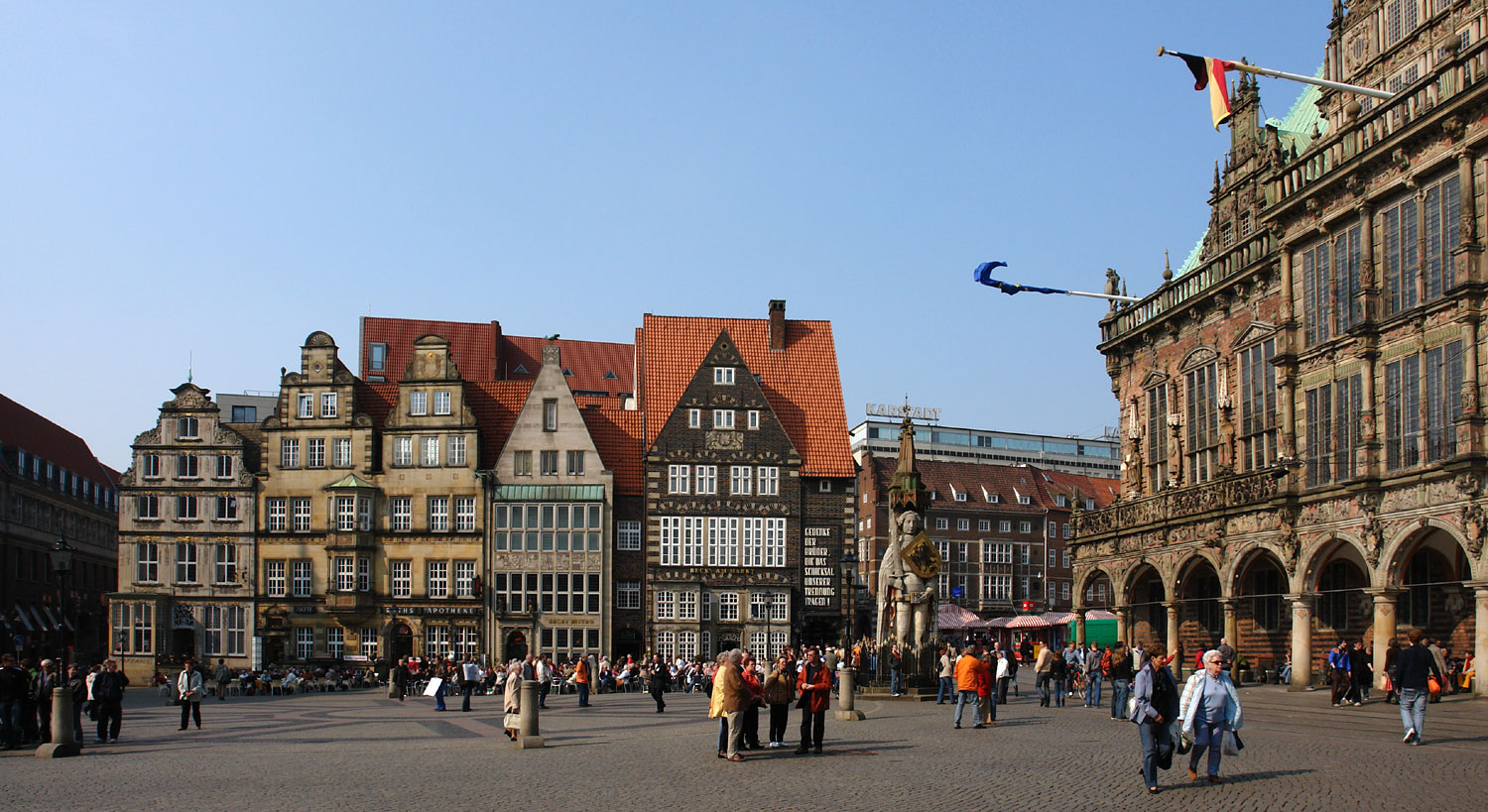Haus Der Stadtsparkasse (Bremen) on:
[Wikipedia]
[Google]
[Amazon]

 Haus der Stadtsparkasse (Stadtsparkasse Building) is a
Haus der Stadtsparkasse (Stadtsparkasse Building) is a

 Haus der Stadtsparkasse (Stadtsparkasse Building) is a
Haus der Stadtsparkasse (Stadtsparkasse Building) is a Rococo
Rococo (, also ), less commonly Roccoco or Late Baroque, is an exceptionally ornamental and theatrical style of architecture, art and decoration which combines asymmetry, scrolling curves, gilding, white and pastel colours, sculpted moulding, ...
landmark on the "Marktplatz
A marketplace or market place is a location where people regularly gather for the purchase and sale of provisions, livestock, and other goods. In different parts of the world, a marketplace may be described as a '' souk'' (from the Arabic), ' ...
" (Market Square) in Bremen
Bremen (Low German also: ''Breem'' or ''Bräm''), officially the City Municipality of Bremen (german: Stadtgemeinde Bremen, ), is the capital of the German state Free Hanseatic City of Bremen (''Freie Hansestadt Bremen''), a two-city-state consis ...
, Germany
Germany,, officially the Federal Republic of Germany, is a country in Central Europe. It is the second most populous country in Europe after Russia, and the most populous member state of the European Union. Germany is situated betwe ...
. It was completed in the 1950s combining the historic front gable from another site with the more recent architecture of the remainder of the building.
History
In 1755, Johann Georg Hoffschlaeger, a wine merchant and city counsellor, had a house built on a site now designated as No. 31B, An der Schlachte. The stonemason Theophilus Wilhelm Frese (1696–1763) decorated the façade in the Rococo style, with abow window
A bow window or compass window is a curved bay window. Bow windows are designed to create space by projecting beyond the exterior wall of a building, and to provide a wider view of the garden or street outside and typically combine four or more w ...
and a gable topped with a wig.
In 1836, the building was bought by Georg Friedrich Pflüger who used it as an inn named ''Stadt Paris'' (City of Paris). In 1875, the property was taken over by Carl Wilhelm Meyer, a publicly appointed sampler. In the early 20th century, a new building designed by Albert Dunkel maintained the Rococo façade.
The building was destroyed in the second world war
World War II or the Second World War, often abbreviated as WWII or WW2, was a world war that lasted from 1939 to 1945. It involved the vast majority of the world's countries—including all of the great powers—forming two opposin ...
by an airstrike
An airstrike, air strike or air raid is an offensive operation carried out by aircraft. Air strikes are delivered from aircraft such as blimps, balloons, fighters, heavy bombers, ground attack aircraft, attack helicopters and drones. The offic ...
with incendiary bombs in 1944. Rudolf Stein, who later became Bremen's monument conservator, saved some of the debris
Debris (, ) is rubble, wreckage, ruins, litter and discarded garbage/refuse/trash, scattered remains of something destroyed, or, as in geology, large rock fragments left by a melting glacier, etc. Depending on context, ''debris'' can refer to ...
including the façade. In 1957/58, the building was reconstructed on a new site on the corner of Langenstraße and Marktplatz. After a call for tenders, it was designed by the architect Eberhard Gildemeister
Eberhard Gildemeister (1897–1978) was a German architect who was mainly active in Bremen. In addition to a number of churches and residential buildings, he designed the Sparkasse building on Bremen's market square.
Early life
Born in Bremen, ...
(1897–1978) assisted by the sculptors Maria Ewel and Ingeborg Ahner-Siese. They used original building elements from the façade of the Schlachte building, adhering to the original style. Eberhard successfully combined the building's red-bricked lateral walls with the historic façade. The interior, however, was finished essentially in the style of the 1950s. A notable design feature is the new door with a skylight
A skylight (sometimes called a rooflight) is a light-permitting structure or window, usually made of transparent or translucent glass, that forms all or part of the roof space of a building for daylighting and ventilation purposes.
History
Open ...
on the market side. The internal decoration, too, contains many Baroque
The Baroque (, ; ) is a style of architecture, music, dance, painting, sculpture, poetry, and other arts that flourished in Europe from the early 17th century until the 1750s. In the territories of the Spanish and Portuguese empires including t ...
elements.
Today, the building houses a branch office
A branch office is an outlet of a company or, more generally, an organization that – unlike a subsidiary – does not constitute a separate legal entity, while being physically separated from the organization's main office. Branching is particu ...
of the ''Sparkasse'', a municipal savings bank.
Heritage listing
In 1973, the building was listed as a historic monument. The ensemble on the north side of the Market Place consists of four buildings, from right to left: * No. 1 Rathscafé/Deutsches Haus, 1908-1911 and 1951-1956 * No. 9 Haus zum Jonas, 1600 and 1963 * No. 11 Raths-Apotheke, 1893-1894 and 1959-1960 * No. 12 Haus der Stadtsparkasse, 1755 and 1957-1958Further reading
* * Eberhard Gildemeister: ''Das Haus der Familie Pflüger an der Schlachte''. In: ''Vom Leben und Schicksal bremischer Bauten in Stadt und Land'', Bremen 1949 * Rudolf Stein: ''Bremer Barock und Rokoko'', 1960 * * Dehio Bremen/Niedersachsen 1992References